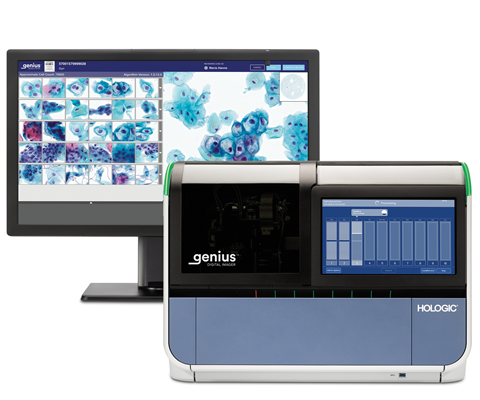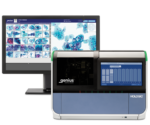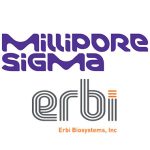In February, the FDA granted marketing clearance of the Hologic Genius Digital Diagnostics System, which uses deep learning-based artificial intelligence (AI) and advanced volumetric imaging technology to help identify pre-cancerous lesions and cervical cancer cells. The system, which scans cytology slides to create digital images, and then applies an AI algorithm to highlight cells that require further review by the cytologist or pathologist, is already commercially available in Europe, Australia and New Zealand.
“Cervical cytology is looking for the proverbial needle in a haystack,” said Mike Quick, Vice President of R&D Innovation at Hologic, who led the development of the technology. “When you’re looking at pap tests that are collected from patients, the vast majority of patients are negative, so you’re looking for a small number of abnormal cells out of an entire population of normal cells. It can be very tedious, time consuming and certainly error prone.”

The Genius System analyzes the roughly 70,000 to 80,000 cells on every patient sample, looks for the ones that are most diagnostic, and distills that down to the 30 images that are most representative of that patient’s diagnosis. The cytologist or pathologist is then presented with a gallery on the screen of the selected images. “Every slide goes into the system and is scanned, and every slide is reviewed,” said Quick.
Dr. Hans Ikenberg, a specialist in gynecology and obstetrics, and Deputy Managing Director of CytoMol, a Medical Care Center (MVZ) for cytology and molecular biology in Frankfurt, Germany, has been using the system since it received its CE Mark three years ago. During the first year of implementation, Dr. Ikenberg and his colleagues performed a retrospective study where they compared cases from the year before blinded with the new system. Once they were satisfied with the accuracy of the system, it went into routine use in the lab.
“After the first year, we were positively surprised that the data we acquired met our expectations,” said Dr. Ikenberg. “There were three aspects to consider: one was sensitivity and specificity, the other was the workload, and third was acceptance of the system by the cyto techs and the pathologists. And all three criteria were fully met by the system.”
Though the system came to market recently, Hologic began preparing for an AI-based cytology system more than 30 years ago with the development of the ThinPrep liquid-based pap test. “The pap test was one of the best cancer screening tests for decades, but the technology remained largely unchanged until 1996 with the advent of liquid-based cytology,” said Quick. “The reason we developed liquid-based cytology was because we found that the preparations of conventional pap smears were so poor that they were not suitable for image analysis and automation in a way that would be scalable. In many ways, the Genius System is the culmination of the work we started back in the late ’80s and early ’90s to be able to combine both the preparation of the sample with the ThinPrep pap test and now the automation with the Genius.”

One of the first challenges that Dr. Ikenberg’s team had to address was skepticism due to the speed and ease of use of the system relative to manual methods. “It was very easy to adopt — perhaps too easy. In the first weeks, most of the cyto techs would take each slide that had gone through the system and put it under the traditional microscope to see whether they saw more than the system had presented them with. After some time that was reduced to the more or less abnormal cases, and finally now it is only special cases — about 5% to 10% — that are controversial or of special interest based on the patient’s medical history, for example. These are taken out of the storage device and physically viewed under a traditional microscope.”
To train the algorithm, Hologic worked with laboratories both internationally and across the U.S. to source the tens of thousands of cases needed to ensure both age and geographic diversity. “Today, we have a large install base throughout Europe in a variety of laboratory settings including smaller hospitals and large laboratory settings,” said Quick. “In virtually all of these labs they’re using the system in a primary diagnosis setting.”
In terms of the performance and the benefits of the Genuis System versus traditional diagnostic methods, “it is at least as good as the up-to-now gold standard and probably a bit better in terms of sensitivity and specificity,” said De. Ikenberg. “It reduces the workload and allows us to focus on the screening of rare abnormalities or borderline cases, which never make up more than 5% to 10% of cases.”
Quick, who also serves as President of the Digital Pathology Association, notes that the FDA clearance is a milestone not only for Hologic, but for the field of pathology as a whole. “When you think about pathology and diagnostics today versus even 10 years ago, the amount of work and the complexity of what we do has grown astronomically,” he said. “That’s where AI can come in and be a valuable tool. There’s nothing magical about AI. It is a tool, and this is the first time that we’re aware of where it’s being put in this primary cancer screening diagnosis setting for a test that’s done for virtually all women across the U.S. It sets a foundation for the field going forward in terms of initial applications to help bring more tools to the space over time.”







